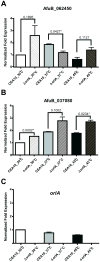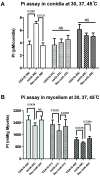Trehalose 6-phosphate phosphatase is required for cell wall integrity and fungal virulence but not trehalose biosynthesis in the human fungal pathogen Aspergillus fumigatus
- PMID: 20545865
- PMCID: PMC2954268
- DOI: 10.1111/j.1365-2958.2010.07254.x
Trehalose 6-phosphate phosphatase is required for cell wall integrity and fungal virulence but not trehalose biosynthesis in the human fungal pathogen Aspergillus fumigatus
Abstract
The trehalose biosynthesis pathway is critical for virulence in human and plant fungal pathogens. In this study, we tested the hypothesis that trehalose 6-phosphate phosphatase (T6PP) is required for Aspergillus fumigatus virulence. A mutant of the A. fumigatus T6PP, OrlA, displayed severe morphological defects related to asexual reproduction when grown on glucose (1%) minimal media. These defects could be rescued by addition of osmotic stabilizers, reduction in incubation temperature or increase in glucose levels (> 4%). Subsequent examination of the mutant with cell wall perturbing agents revealed a link between cell wall biosynthesis and trehalose 6-phosphate (T6P) levels. As expected, high levels of T6P accumulated in the absence of OrlA resulting in depletion of free inorganic phosphate and inhibition of hexokinase activity. Surprisingly, trehalose production persisted in the absence of OrlA. Further analyses revealed that A. fumigatus contains two trehalose phosphorylases that may be responsible for trehalose production in the absence of OrlA. Despite a normal growth rate under in vitro growth conditions, the orlA mutant was virtually avirulent in two distinct murine models of invasive pulmonary aspergillosis. Our results suggest that further study of this pathway will lead to new insights into regulation of fungal cell wall biosynthesis and virulence.
© 2010 Blackwell Publishing Ltd.
Figures











Similar articles
-
Aspergillus fumigatus Trehalose-Regulatory Subunit Homolog Moonlights To Mediate Cell Wall Homeostasis through Modulation of Chitin Synthase Activity.mBio. 2017 Apr 25;8(2):e00056-17. doi: 10.1128/mBio.00056-17. mBio. 2017. PMID: 28442603 Free PMC article.
-
An Ssd1 Homolog Impacts Trehalose and Chitin Biosynthesis and Contributes to Virulence in Aspergillus fumigatus.mSphere. 2019 May 8;4(3):e00244-19. doi: 10.1128/mSphere.00244-19. mSphere. 2019. PMID: 31068436 Free PMC article.
-
Two KTR Mannosyltransferases Are Responsible for the Biosynthesis of Cell Wall Mannans and Control Polarized Growth in Aspergillus fumigatus.mBio. 2019 Feb 12;10(1):e02647-18. doi: 10.1128/mBio.02647-18. mBio. 2019. PMID: 30755510 Free PMC article.
-
Central Role of the Trehalose Biosynthesis Pathway in the Pathogenesis of Human Fungal Infections: Opportunities and Challenges for Therapeutic Development.Microbiol Mol Biol Rev. 2017 Mar 15;81(2):e00053-16. doi: 10.1128/MMBR.00053-16. Print 2017 Jun. Microbiol Mol Biol Rev. 2017. PMID: 28298477 Free PMC article. Review.
-
The Cell Wall of the Human Fungal Pathogen Aspergillus fumigatus: Biosynthesis, Organization, Immune Response, and Virulence.Annu Rev Microbiol. 2017 Sep 8;71:99-116. doi: 10.1146/annurev-micro-030117-020406. Epub 2017 Jul 12. Annu Rev Microbiol. 2017. PMID: 28701066 Review.
Cited by
-
Phosphomannose Isomerase Is Involved in Development, Stress Responses, and Pathogenicity of Aspergillus flavus.Microbiol Spectr. 2022 Oct 26;10(5):e0202722. doi: 10.1128/spectrum.02027-22. Epub 2022 Aug 18. Microbiol Spectr. 2022. PMID: 35980200 Free PMC article.
-
Functional validation of pathogenicity genes in rice sheath blight pathogen Rhizoctonia solani by a novel host-induced gene silencing system.Mol Plant Pathol. 2021 Dec;22(12):1587-1598. doi: 10.1111/mpp.13130. Epub 2021 Aug 27. Mol Plant Pathol. 2021. PMID: 34453407 Free PMC article.
-
Chitin Biosynthesis in Aspergillus Species.J Fungi (Basel). 2023 Jan 6;9(1):89. doi: 10.3390/jof9010089. J Fungi (Basel). 2023. PMID: 36675910 Free PMC article. Review.
-
Pathway of glycine betaine biosynthesis in Aspergillus fumigatus.Eukaryot Cell. 2013 Jun;12(6):853-63. doi: 10.1128/EC.00348-12. Epub 2013 Apr 5. Eukaryot Cell. 2013. PMID: 23563483 Free PMC article.
-
The lactic acid bacteria metabolite phenyllactic acid inhibits both radial growth and sporulation of filamentous fungi.BMC Res Notes. 2013 Nov 14;6:464. doi: 10.1186/1756-0500-6-464. BMC Res Notes. 2013. PMID: 24229396 Free PMC article.
References
-
- Aisaka K, Masuda T. Production of trehalose phosphorylase by Catellatospora ferruginea. FEMS Microbiol Lett. 1995;131:47–51. - PubMed
-
- Aisaka K, Masuda T, Chikamune T, Kamitori K. Purification and characterization of trehalose phosphorylase from Catellatospora ferruginea. Biosci Biotechnol Biochem. 1998;62:782–787. - PubMed
-
- Anderson PJ, Karageuzian LN, Cheng HM, Epstein DL. Hexokinase of calf trabecular meshwork. Invest Ophthalmol Vis Sci. 1984;25:1258–1261. - PubMed
-
- Aufauvre-Brown A, Mellado E, Gow NAR, Holden DW. Aspergillus fumigatus chsE: A Gene Related to CHS3 of Saccharomyces cerevisiae and Important for Hyphal Growth and Conidiophore Development but Not Pathogenicity. Fungal Genet Biol. 1997;21:141–152. - PubMed
Publication types
MeSH terms
Substances
Grants and funding
LinkOut - more resources
Full Text Sources
Other Literature Sources
Molecular Biology Databases
Research Materials

